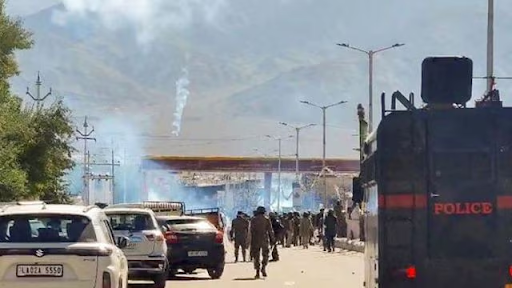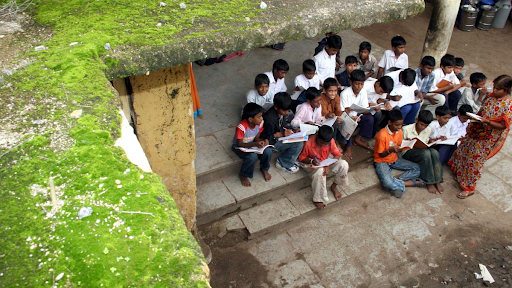Description

Copyright infringement not intended
Context: As the violence in Manipur worsened, the state government permitted all District Magistrates to issue "shoot-at-sight orders" in "extreme cases."
Details
- The directive came a day after violent skirmishes erupted in various locations during the 'Tribal Solidarity March' organised by the All Tribal Students' Union of Manipur (ATSUM).
- The march was held in response to the demand that the state's Meitei community be classified as a Scheduled Tribe (ST).
Conflict in Manipur
- The northeastern state of Manipur has been witnessing violent clashes between tribal and non-tribal groups over the issue of granting Scheduled Tribe (ST) status to the Meitei community, which constitutes about 64% of the state’s population.
- The Meitei community has been demanding ST status for decades, claiming that they are socio-economically disadvantaged and need affirmative action to uplift them.
- The tribal groups have opposed this demand, fearing that it would dilute their rights and opportunities.
- The situation escalated on May 3, 2023, when thousands of tribal people participated in a ‘Tribal Solidarity March’ organized by the All Tribal Students’ Union of Manipur (ATSUM) to protest against a recent order by the Manipur High Court that asked the government to consider the Meitei demand for ST status.
- The march turned violent as some protesters clashed with Meitei residents and set fire to vehicles and buildings in several parts of the state.
- The state government imposed a curfew and suspended mobile internet services to prevent further violence.
- The governor of Manipur also issued ‘shoot at sight’ orders to restore law and order.

Shoot at Sight Order
About
- Shoot-at-sight orders are a controversial and rare form of law enforcement in India.
- They are issued by the authorities when they deem that there is an imminent threat to public order or security and that the use of lethal force is necessary to prevent it.
- The orders authorize the police or other security forces to shoot anyone who violates the orders, without any warning or attempt to arrest them.
- ‘Shoot at sight’ orders are usually issued for a limited period and for specific areas where there is a high risk of violence.
Legal Basis for Shoot-at-Sight Orders
- The legal basis for shoot-at-sight orders in India is unclear and disputed.
- Some argue that they are derived from Section 46 of the Code of Criminal Procedure, 1973, which allows the police to use “all means necessary” to effect an arrest, including causing death if the person cannot be arrested otherwise.
- Others claim that they are based on Section 100 of the Indian Penal Code, 1860, which permits a person to cause death in self-defence or defence of others when there is a reasonable apprehension of death or grievous hurt.
- However, both these provisions have limitations and conditions that do not justify the blanket use of shoot-at-sight orders. For instance, Section 46 requires that the person being arrested must be accused of an offence punishable with death or imprisonment for life and that he must resist or attempt to evade arrest.
- Section 100 requires that there must be no other way of averting the danger and that the force used must be proportionate to the threat.
Not Arbitrary or Absolute
- Shoot-at-sight orders are not arbitrary or absolute.
- They have to be issued by a competent authority, such as the governor or the chief minister of a state, after consulting with other officials and assessing the situation.
- They also have to be in accordance with the law and human rights norms.
- The security forces have to exercise restraint and proportionality while using force and ensure that innocent civilians are not harmed.
- They also have to follow certain rules of engagement, such as identifying themselves, giving clear instructions, warning shots, etc. before opening fire.
Subject to Judicial Review and Accountability
- Shoot-at-sight orders are also subject to judicial review and accountability.
- Anyone who is affected by such orders can approach the courts for relief or compensation.
- The security forces can also be held liable for any misuse or excess of force.

Concern
- These orders authorize the use of lethal force against anyone who violates the curfew or engages in acts of arson, looting, or vandalism. While these orders may seem necessary to restore law and order, they also raise serious human rights and legal concerns.
Violate the right to life and the Principle of Proportionality
- The right to life is a fundamental human right that is protected by the Indian Constitution and international law.
- It can only be restricted in exceptional circumstances, such as when there is an imminent threat to life or public safety.
- The principle of proportionality requires that any use of force must be necessary, reasonable, and proportionate to the threat posed.
- ‘Shoot at sight’ orders do not meet these criteria, as they allow for indiscriminate and excessive use of force against anyone who is suspected of breaking the law, regardless of the nature or gravity of their offence.
Undermine the rule of law and due Process
- The rule of law means that everyone is equal before the law and subject to its fair and impartial administration.
- Due process means that everyone has the right to a fair trial and a presumption of innocence until proven guilty.
- ‘Shoot at sight’ orders bypass these safeguards and grant the security forces a license to kill without any accountability or oversight.
- They also create a climate of fear and intimidation that discourages people from exercising their rights to freedom of expression, assembly, and movement.
Counterproductive and ineffective in addressing the root causes of violence and unrest
- The root causes of violence and unrest are often complex and multifaceted, involving social, economic, political, and historical factors.
- They cannot be solved by brute force alone, but require dialogue, reconciliation, and justice.
- ‘Shoot at sight’ orders only escalate the situation and fuel more resentment, anger, and violence among the affected communities.
- They also erode public trust and confidence in the security forces and the government.
Conclusion
- ‘Shoot at sight’ orders are an exceptional and drastic measure that should be used only as a last resort when all other means of restoring peace have failed. They are not a solution to the underlying causes of violence or conflict, but only a temporary measure to prevent further escalation.
- The authorities have to ensure that such orders are not misused or abused and that they respect the rights and dignity of all people.
|
PRACTICE QUESTION
Q. The recent violence in Manipur has raised concerns about the legality and morality of 'shoot at sight' orders issued by the authorities. What are these orders and how can they be imposed in a democratic country? How do they affect the human rights and security of the people? What are the root causes of the conflict in Manipur and what can be done to resolve it peacefully?
|

https://indianexpress.com/article/explained/explained-law/manipur-violence-shoot-at-sight-orders-8593823/











